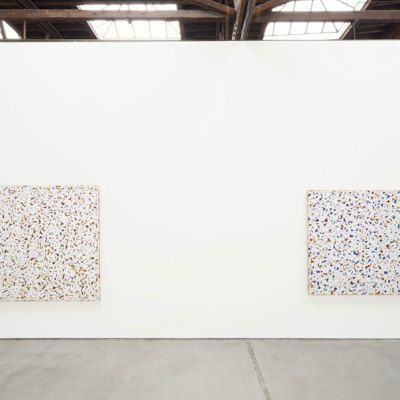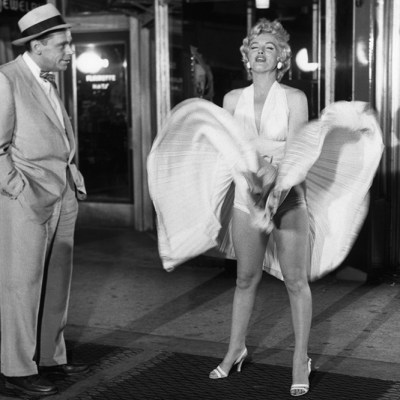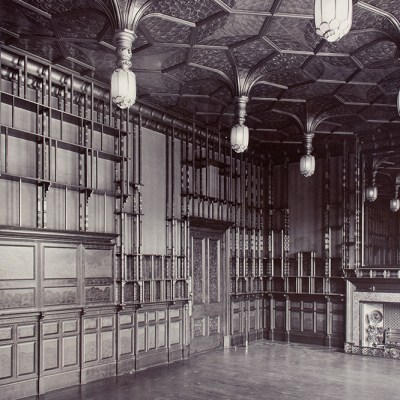It’s easy to forget you’re looking at works of art in David Zwirner’s exhibit of early white-on-white works by Robert Ryman. The protruding globs might make you think the gallery preppers missed a spot when painting the walls. Upon closer inspection, however, the canvases swirl with exciting brushwork. The fact that it’s difficult to differentiate between the work and the wall is part of their quiet thrill. In fact, when Ryman had his first big show at MoMA, the critic Robert Hughes wrote that it was a good move to leave out wall labels because they would have stolen your attention from the art.
If you take a step back and look at more than one work at the same time, all the white squares – and they are all white squares – might seem the same. Some artists become obsessed with a theme and repeat themselves for a time. Rarely are they so obsessed with a single idea that they pursue it for their whole lives as Ryman did.
Untitled (c. 1962), Robert Ryman. © 2023 Robert Ryman/Artists Rights Society (ARS), New York

However, to think that Ryman was doing exactly the same thing each time reveals our own biases about what we expect from a painting. Some of his white squares are on canvas, some on steel, some on wood; some use thick paint, some thin; some use different brands of white paint. Is an artist ‘repeating’ themselves for having a distinctive style? We are quicker to say that Ryman repeated himself than to say Van Gogh did, even though all his paintings feature the same kind of brushwork and only the subjects change. Every artist repeats something and what’s repeated recedes into the background, so that the rest can come to the fore. Ryman regarded himself as a realist, but he wasn’t interested in representation. He claimed that his paintings are real in themselves. They are not paintings of white; they are white.
In an interview published in the Brooklyn Rail in 2008, Ryman was asked if there is a transcendental aspect in his work. He replied, ‘I don’t even know what that means.’ His canvases do pose questions such as ‘What is a painting?’ and ‘What is colour?’ – but not in an existential way. The problems he set himself were more practical. It took only one more question in that interview before he was back to talking about the material qualities of epoxy paint.
Untitled (c. 1963–2010), Robert Ryman. © 2023 Robert Ryman/Artists Rights Society (ARS), New York

Many of the paintings in the exhibition at David Zwirner reveal how they were made. One features three embedded squares, showing how the painting changes after each layer of gesso and underpainting. Another has a palette of paints placed straight on the canvas. One long, upright frame holds a stack of three square paintings filled with white squiggles, counted off – ‘1’, ‘2’, ‘3’ – a subtle, or perhaps not-so-subtle nod to his repetitive practice.
It’s worth remembering that Ryman’s first ambition, before he wanted to be a painter, was to play jazz. Does it make sense to think of him practising? Perhaps not, since there’s no direct analogy between music and visual art. (I once told an artist friend of mine that I was going to make a practice painting and he said, ‘That’s just a painting.’)
Untitled (c. 1961), Robert Ryman. © 2023 Robert Ryman/Artists Rights Society (ARS), New York

Ryman’s repetitiveness is deliberate. By focusing on one constant feature, we can study it from all angles and understand its folds and nuances. In his case, we can focus on the material and textural qualities of the paint itself. Many marks feel as if they were laid on with the same flick of the wrist involved in smacking concrete on to a wall when laying bricks. The white of Ryman’s work enables detritus on the surfaces of the paintings to become visible. I think I spent time on one painting trying to figure out if a particular line was a hair or a crack in the paint. I actively had to resist the urge to pick off nubs of paint, like popping a pimple.
In addition to white squares, another thing Ryman repeats is his name. Some paintings have more than one signature. Others are only a series of signatures. Perhaps he wanted to remind us that the painting was made by a person; it wasn’t a defective canvas from the store. Or perhaps he needed to emphasise his separation from Rauschenberg and Malevich and other white-on-white artists who came before him.
Untitled (c. 1964), Robert Ryman. © 2023 Robert Ryman/Artists Rights Society (ARS), New York

Did it get boring painting the same thing over and over again? I certainly didn’t feel bored looking at the works, which feels like a testament to Ryman’s profound intuitions about what makes a work exciting. (Did he develop this sense during the seven years he spent as a security guard at MoMA?) Sticking to one subject gives that subject room to breathe, and it gives the viewer space to think about it. Perhaps the real reason Ryman repeated himself so much is because he had so much to say.
‘Robert Ryman: 1961–1964’ is at David Zwirner, New York, until 3 February 2024.



